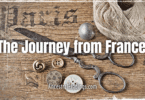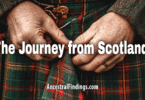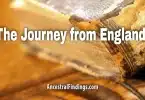If you have ancestors who came to North America before the 20th century, there’s a strong possibility that part of your family story began in Scotland. From the rugged Highlands to the fertile Lowlands, from fishing villages on the coast to industrial Glasgow, Scotland has been sending its sons and daughters abroad for centuries.
Scottish emigrants left behind misty glens, clan lands, and centuries of tradition — but they carried with them an education system admired throughout Europe, a fierce sense of independence, and a reputation for honesty, perseverance, and wit. Their descendants helped shape North America’s politics, religion, art, and even its landscapes.
Finding Scottish roots isn’t just about identifying surnames. It’s about tracing the movement of a people who valued both family and freedom — a balance that defined their identity wherever they went.
A Land of Clans, Crofters, and Change
To understand Scottish ancestry, you have to know what Scotland was before its great migrations began. The land itself — carved by glaciers and battered by sea wind — shaped the people who lived on it.
The Highlands, stretching from Inverness to the Western Isles, remained remote and traditional well into the 18th century. Gaelic was the language, cattle and sheep the lifeblood, and kinship the structure of society. People lived in small farming communities called clachans, organized under extended families and clans.
The Lowlands, by contrast, were more urban, more literate, and more open to trade with England and Europe. Towns like Edinburgh, Dundee, and Glasgow became centers of commerce, learning, and reform. Many Lowlanders — especially Presbyterians — were among the earliest emigrants, leaving Scotland voluntarily for business or religious opportunity abroad.
But it was the Highland Clearances — a series of forced evictions between 1760 and 1850 — that transformed Scottish migration forever.
The Highland Clearances: When the Old Ways Fell Silent
For centuries, Highlanders lived under the protection of their clan chiefs, who acted as both landlords and leaders. But as the economy changed, many chiefs became more interested in profit than kinship. They replaced tenant farmers with more profitable sheep farming, and entire villages were cleared with little warning.
Families who had lived on the same glen for generations were given passage to Canada, the Carolinas, and later New Zealand and Australia. Others fled to the crowded slums of Glasgow. The Gaelic word fuadach — meaning eviction or displacement — became part of every Highlander’s vocabulary.
These migrations weren’t just economic. They were deeply emotional. Many of the emigrants never saw their homeland again, yet they kept its memory alive through music, stories, and family traditions. Even today, Scottish descendants often speak of a longing for a place they’ve never seen — a cultural echo of the Clearances that still lingers.
Lowland Scots and the Rise of the Scotch-Irish
While Highlanders often left under duress, Lowlanders migrated by choice. In the 1600s, thousands of them settled in Ulster, Northern Ireland, under the Plantation of Ulster, encouraged by the Scottish crown.
Over generations, these settlers became known as the Scotch-Irish — Scots who had lived in Ireland before migrating again to North America. They formed one of the largest early immigrant groups to the American colonies, especially in Pennsylvania, Virginia, and the Appalachian frontier.
If your American ancestors were early Presbyterians, pioneers in the Blue Ridge or the Ozarks, or veterans of the Revolutionary War, there’s a good chance they were of Scotch-Irish descent. Their legacy still shapes much of American culture — from Appalachian folk music to a spirit of self-reliance that became part of the national identity.
Understanding the Clan System
When most people think of Scottish heritage, they picture tartans, bagpipes, and famous clan names. While those symbols have real meaning, the clan system was far more complex than popular legend suggests.
A clan was less a family tree and more a community of loyalty and protection. Not everyone bearing the same surname was a blood relative. Tenants, allies, and workers might take the chief’s name for security or allegiance.
For genealogists, this means a surname like MacDonald, Campbell, or Fraser may not connect directly to a chief’s bloodline, but it can identify the region or historical context of origin.
To explore your clan connection:
- Visit the Standing Council of Scottish Chiefs to identify legitimate clan associations.
- Research the Scottish Register of Tartans, which documents the patterns and colors connected with families and regions.
- Review clan-specific genealogy sites or societies, which often include detailed family trees and DNA projects.
The Clues Hidden in Naming Patterns
Traditional naming customs can reveal generations at a glance. From the 1700s through much of the 1800s, Scots followed predictable naming patterns:
- The first son was named after the paternal grandfather.
- The second son after the maternal grandfather.
- The first daughter after the maternal grandmother.
- The second daughter after the paternal grandmother.
When you see repeating names in records — a Robert, an Agnes, and another Robert — these patterns can help you distinguish between cousins, uncles, and branches of the same family. It’s one of the most effective tools for sorting through Scottish census data or parish registers, especially in areas where a few surnames dominate entire parishes.
Where to Find Your Scottish Ancestors in the Records
Scotland is a treasure for genealogists because it maintained and preserved records with remarkable care. The best part: almost everything can be accessed digitally.
1. ScotlandsPeople.gov.uk
The official government portal for all Scottish records. You’ll find digitized Old Parish Registers (OPRs), civil registrations, census returns, wills, and even Sasine property records. The site is pay-per-view, but the images are crystal clear and the indexes reliable.
2. Parish Registers (1500s–1854)
Before civil registration began, the Church of Scotland kept baptism, marriage, and burial records. Many of these entries include parents’ names and even occupation — rare for the time.
3. Civil Registration (1855–present)
Scotland’s civil records began later than England’s but contain far more detail. Birth certificates list both parents and their marriage date; marriage certificates include both sets of parents; and death certificates list parents’ names even when the deceased was elderly.
4. Census Records (1841–1911)
Censuses show households by name, age, occupation, and birthplace. The Scottish census is particularly rich in detail, helping track movement from farm to city during industrialization.
5. Valuation Rolls and Sasine Registers
Property records reveal where your ancestors lived, what land they rented or owned, and sometimes the conditions of their tenancy. The Sasine Registers (dating from the 1600s) record every land transaction in Scotland — an extraordinary resource for tracing long-settled families.
6. Wills and Testaments
The National Records of Scotland holds wills and inventories dating to the 1500s. These often name multiple generations, servants, and neighbors, offering a vivid glimpse into daily life.
Scottish Immigration to North America
Scottish immigration occurred in waves:
- 1600s: Lowland Scots settle in Ulster (later Scotch-Irish).
- 1700s: Highlanders arrive after the Clearances, many settling in Nova Scotia (“New Scotland”), Prince Edward Island, and North Carolina.
- 1800s: Industrial workers, artisans, and professionals emigrate to Canada and the northern United States.
- 1900s: The last major wave includes shipbuilders, engineers, and scholars seeking economic opportunity abroad.
Ports like Glasgow, Greenock, and Leith saw families depart for voyages lasting up to six weeks. Ships bound for Halifax, Quebec, or New York often carried entire Highland communities — cousins, neighbors, and friends who would settle together once they landed.
If your ancestors came through Nova Scotia, you’ll find deep Scottish roots in Cape Breton, Antigonish, and Pictou. In the United States, North and South Carolina were major centers of Highland settlement, especially before the Revolution.
Finding Your Family’s Place in the Scottish Diaspora
When researching emigrant ancestors, work backward from where they settled. Check:
- Early land grants and township maps in Canada and the U.S. (many list Scottish surnames).
- Passenger lists from Glasgow, Liverpool, and Belfast.
- Military pension rolls — many Scots served in the British Army or colonial militias.
- Church records — Scottish settlers often founded Presbyterian or Free Churches that maintained excellent membership lists.
DNA testing can now connect you directly to Scottish regions or even clans. Companies like AncestryDNA and FamilyTreeDNA map genetic clusters such as Argyll, Aberdeenshire, or the Hebrides, allowing you to pinpoint your ancestral region with surprising accuracy.
Everyday Clues to a Scottish Past
Sometimes the simplest details confirm what records cannot. Look for:
- Family stories mentioning a “Highland” or “Scotch” ancestor.
- Family Bibles, portraits, or letters referencing places like Ayrshire, Inverness, or Glasgow.
- Music, proverbs, or heirlooms passed down through generations.
- A recurring pride in education, ministry, or craftsmanship — values central to Scottish culture.
Even if documentation is thin, these threads often lead to the right records once you know where to look.
A Legacy That Endures
The story of Scottish ancestry is one of resilience and adaptation. Scots became settlers, teachers, soldiers, and inventors across the world. Their descendants helped shape towns, universities, and political thought on every continent.
When you trace your Scottish line, you’re not just uncovering ancestors — you’re rediscovering a worldview built on faith, learning, and endurance.
The voice of Scotland still speaks through her descendants, from the sound of the pipes at a Highland Games to the simple pride of a family name carried across oceans.
Share Your Story
Do you have Scottish ancestors? Maybe you’ve discovered your family’s clan, a ship record, or a story that links your name to the Highlands or Lowlands. I’d love to hear about it.
You can share your family’s journey and discoveries in the comments on YouTube or Facebook. Your story might help others uncover their own Scottish roots — and together, we’ll continue building this shared history through Journeys of Our Ancestors.






